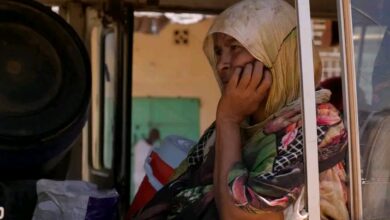Collapse of Healthcare in Sudan’s Conflict Zones Forces Women Back to Traditional “Rope Birth” Practices
Report – Mashawir

The protracted war in Sudan between the army and the Rapid Support Forces (RSF), ongoing since April 2023, has led to a deepening healthcare crisis. With over 80% of hospitals and clinics in active conflict areas out of service—and even distant medical institutions severely affected—millions are left without access to essential health services. Among the most affected are women, especially pregnant ones, who face a total collapse of reproductive healthcare.
Many have died or suffered complications such as fetal poisoning due to stillbirths, severe anemia from malnutrition, and vitamin deficiencies weakening their ability to carry pregnancies to term. Others are forced to give birth during displacement or in makeshift camps where there is no emergency medical access, no ambulances, and no functioning communication infrastructure.
These dire conditions have forced women in conflict zones and remote rural areas to revert to an ancient method known as “rope birth”, assisted by traditional midwives whose skills have been passed down through generations. This method is a double-edged sword—while it may allow for a natural birth in some cases, it poses serious risks when complications arise, particularly in women subjected to pharaonic circumcision, which complicates labor.
Risks and Warnings
The World Health Organization (WHO), the United Nations Population Fund (UNFPA), and other partners have warned that ongoing attacks on healthcare infrastructure could lead to catastrophic consequences. Specialized maternity hospitals offering reproductive and sexual health services and family planning consultations have been destroyed or shut down. According to recent WHO data, over 4 million women of reproductive age, including approximately 500,000 pregnant women, have lost access to these services and now face life-threatening conditions.
Meanwhile, the UNFPA notes that Sudan has trained more than 27,000 midwives at the Omdurman School of Midwifery, many of whom are legally certified and scattered across the country.
Efforts are being made by WHO in partnership with Sudan’s Ministry of Health to restore maternity services, but there is a pressing need to ensure the safety and well-being of pregnant women in Khartoum, Al-Jazirah, Darfur, Kordofan, the Blue Nile, and all displacement-hosting states.
Persistent Struggles
Veteran midwife Halima Abu, who has practiced for 50 years, reflected on the re-emergence of rope birth:
> “It may be hard to believe, but despite modern reproductive care and technological advancements, rope birth remains common—especially in Darfur and South Kordofan due to traditional customs and ethnic diversity. I myself practiced this method extensively and safely in the 1970s while traveling with my husband, a railway worker. I never witnessed a woman die under the care of a traditional midwife back then.”
Abu emphasized that Sudanese midwives are skilled and capable, especially those trained and certified with official midwifery kits.
> “Due to the war and healthcare collapse, the demand for midwives has grown. Sometimes, difficult cases require a C-section, and we risk transferring the woman to a hospital, often through dangerous routes—particularly in Darfur. Sadly, complications do arise, sometimes leading to maternal deaths. These are consequences of civil war. I still practice midwifery despite my age, as I live in a region with a collapsed healthcare system and get called upon frequently.”
The Need for Awareness and Prevention
Social researcher I’timad Al-Rashid noted that the systemic collapse of healthcare has left pregnant women unprotected and pushed many toward unsafe birthing methods, especially in displacement camps often located in remote desert areas.
> “Rope birth never fully disappeared, particularly in Darfur, South Kordofan, the Butana plains, and Northern states. Many women still refuse hospital births.”
She warned that the resurgence of rope birth could significantly raise maternal mortality rates due to the primitive tools involved, such as razor blades, the risk of infection, and unsterile environments.
> “The traditional method involves a sturdy rope hanging from the ceiling, which the laboring woman clings to while kneeling. The midwife uses her inherited skills and physical strength to assist, surrounded by women and nearby male relatives praying for a safe delivery. But such scenarios often end in tragedy.”
Al-Rashid emphasized the need to launch awareness campaigns in rural areas and deliver sexual and reproductive health services to prevent gender-based violence and maternal deaths.
Rising Maternal Deaths
Sudanese Doctors’ Committee member and human rights activist Sayyida Iraqi explained that accurate statistics on maternal deaths are hard to come by due to the lack of monitoring and communication with affected areas. However, the main cause is the return to home births.
> “With hospitals shut down, pregnant women have no access to guidance, prenatal care, or medical delivery—forcing them to rely on midwives. Some survive, but many don’t.”
She also noted that mass displacement following RSF control of large swathes of Sudan exacerbated the situation, with receiving areas unequipped to handle the influx of pregnant women.
A Catastrophic Situation
In South Darfur, reproductive health officer Soheiba Mubarak described the situation as catastrophic:
> “The fate of pregnant women is unknown. Ambulances are scarce, and there’s no safe transportation to the few remaining hospitals. As a result, more women rely on untrained traditional midwives.”
She added,
> “Sadly, many women die from severe postpartum hemorrhage at home, often accompanied by fever. Most pregnant women are also infected with malaria, cholera, or typhoid. With life-saving medicines in short supply, most arrive at hospitals critically ill—often on the brink of death.”
Mubarak concluded by warning that millions of pregnant women in Sudan now face extreme health conditions, relying almost entirely on midwives.
> “Without intervention, childbirth will only become more dangerous. Family planning and maternal health services must be urgently activated.




